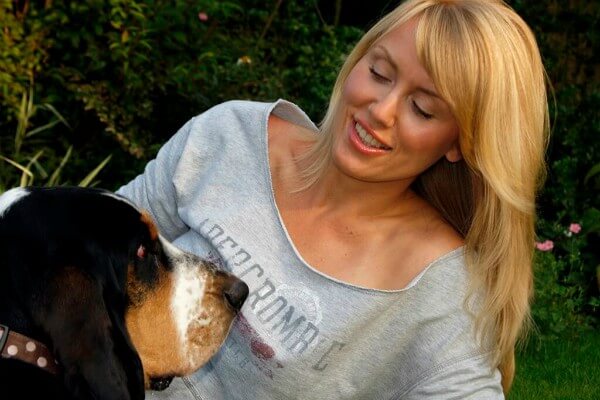Dogs at risk of separation distress after Covid-19 lockdown

The Association of Pet Behaviour Counsellors (APBC) warns dog owners that their pets are at risk of showing separation-related problems at the end of the coronavirus lockdown when they return to work.
Periods of time when dogs have company 24/7 followed by a change in routine that means dogs have to be left at home alone can be a risk factor for separation anxiety, says the Association of Pet Behaviour Counsellors – an international network of experienced and fully qualified pet behaviour counsellors. Dogs in lockdown are delighted to have their humans at home with them all the time. But are owners considering the after-effects of social isolation, when life starts to return to some normality and dogs are left behind without human company?
Hanne Grice, a member of the APBC based in Tring, Hertfordshire (piictured) advises: ‘Not every dog will exhibit separation distress when the routine changes, but dogs who – in hindsight – always seemed a bit unhappy when they were left alone or are particularly clingy now they have company, may be more likely to bark, howl, destroy things or lose control of their bowels when their owners start to leave them again. For some dogs, separation distress can be so severe that they end up self-harming or breaking down doors.
‘The good news is that there are things we can put in place whilst we’re at home to reduce the risk of our dogs struggling when we return to work or start leaving the house without our dogs in tow.’
Top tips for preventing separation anxiety in dogs post lockdown:
- Encourage your dog to settle in their bed whilst you work from home. Initially you might need to put it by your feet, but gradually you can move the bed further away from you and reward your dog for staying in its bed. Eventually the bed can be positioned the other side of a baby gate and then a closed door.
- Spend time in another room away from your dog, and in the garden with your dog inside – consider videoing your dog to check whether they settle when you leave them alone.
- If you’re able to leave the house, aim to leave your dog on their own everyday if they’ve always tolerated being home alone – even if it’s for 10 minutes whilst you pop to the shops or go for some exercise.
- Provide your dog with lots of independently self-reinforcing activities that don’t involve you, such as homemade or commercial activity feeders (objects the dog has to manipulate to get part of their meal portions to fall out), chews, stuffed Kongs to lick at, and toys that the dog can play with by themselves.
- Try to stick to a similar routine to the one you were previously in and the one you are likely to return to – get up at the same time, feed your dog at the same times, provide them with their quiet time when they’d normally sleep and take them on their walk(s) at the same sort of time each day.
If you have a dog who has previously exhibited distress when they’ve been left home alone, this period of restriction is actually an ideal time to get started on a programme to alter their anxieties about isolation. Dogs need to learn to relax when separated from their caregivers and this needs to be taught gradually and systematically with expert help. Hanne is currently providing remote consultations to help owners with their pets. More information can be found at www.doglistener.tv.

